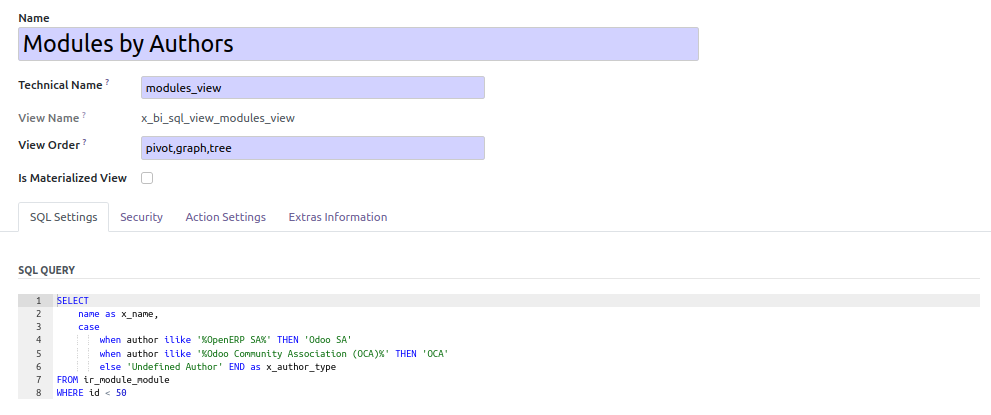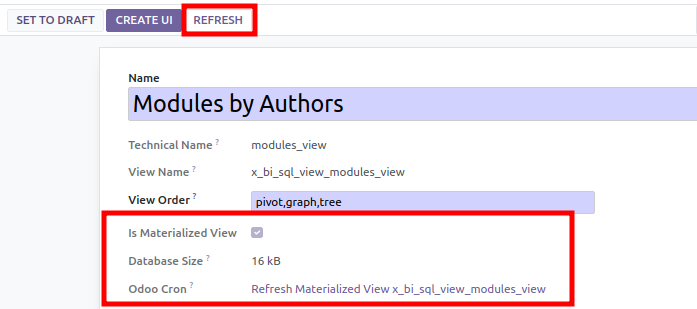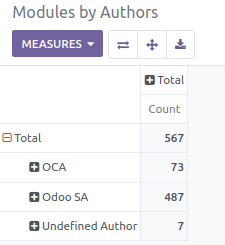BI Views builder, based on Materialized or Normal SQL Views
Project description
This module extends the functionality of reporting, to support creation of extra custom reports. It allows user to write a custom SQL request. (Generally, admin users)
Once written, a new model is generated, and user can map the selected field with odoo fields. Then user ends the process, creating new menu, action and graph view.
Technically, the module create SQL View (or materialized view, if option is checked). Materialized view duplicates datas, but request are fastest. If materialized view is enabled, this module will create a cron task to refresh the data).
By default, users member of ‘SQL Request / User’ can see all the views. You can specify extra groups that have the right to access to a specific view.
Warning
This module is intended for technician people in a company and for Odoo integrators.
It requires the user to know SQL syntax and Odoo models.
If you don’t have such skills, do not try to use this module specially on a production environment.
Use Cases
this module is interesting for the following use cases
You want to realize technical SQL requests, that Odoo framework doesn’t allow (For exemple, UNION with many SELECT) A typical use case is if you want to have Sale Orders and PoS Orders datas in a same table
You want to customize an Odoo report, removing some useless fields and adding some custom ones. In that case, you can simply select the fields of the original report (sale.report model for exemple), and add your custom fields
You have a lot of data, and classical SQL Views have very bad performance. In that case, MATERIALIZED VIEW will be a good solution to reduce display duration
Table of contents
Configuration
Go to Dashboard / Configuration / SQL Views
tip your SQL request
Select the group(s) that could have access to the view
Optionnaly, you can add a domain.
A tipical domain in a multi company context is to write ['|', ('company_id', '=', False), ('company_id', 'in', company_ids)] to make reporting depending on the current companies of the user.
Click on the button ‘Validate SQL Expression’
Once the sql request checked, the module analyses the column of the view, and propose field mapping. For each field, you can decide to create an index and set if it will be displayed on the pivot graph as a column, a row or a measure.
Click on the button ‘Create SQL elements’. (this step could take a while, if view is materialized)
If it’s a MATERIALIZED view:
a cron task is created to refresh the view. You can so define the frequency of the refresh.
the size of view (and the indexes is displayed)
Before applying the final step, you will need to add a specific Parent Menu to use when creating the UI Menu for the report. By default, it will be set with the SQL Views menu, which can be changed before creating the UI elements in order to have the report accessible from a different place within Odoo.
Finally, click on ‘Create UI’, to create new menu, action, graph view and search view.
Usage
To use this module, you need to:
Go to ‘Dashboards > SQL Reports’
Select the desired report
You can switch to ‘Graph’ or ‘tree’ views as any report.
Bug Tracker
Bugs are tracked on GitHub Issues. In case of trouble, please check there if your issue has already been reported. If you spotted it first, help us to smash it by providing a detailed and welcomed feedback.
Do not contact contributors directly about support or help with technical issues.
Credits
Contributors
Sylvain LE GAL (https://twitter.com/legalsylvain)
Richard deMeester, WilldooIT (http://www.willdooit.com/)
David James, WilldooIT (http://www.willdooit.com/)
Guillem Casassas <guillem.casassas@forgeflow.com>
- This module is highly inspired by the work of
Onestein: (http://www.onestein.nl/) Module: OCA/server-tools/bi_view_editor. Link: https://github.com/OCA/reporting-engine/tree/9.0/bi_view_editor
Anybox: (https://anybox.fr/) Module : OCA/server-tools/materialized_sql_view link: https://github.com/OCA/server-tools/pull/110
GRAP, Groupement Régional Alimentaire de Proximité: (http://www.grap.coop/) Module: grap/odoo-addons-misc/pos_sale_reporting link: https://github.com/grap/odoo-addons-misc/tree/7.0/pos_sale_reporting
Maintainers
This module is maintained by the OCA.

OCA, or the Odoo Community Association, is a nonprofit organization whose mission is to support the collaborative development of Odoo features and promote its widespread use.
Current maintainer:
This module is part of the OCA/reporting-engine project on GitHub.
You are welcome to contribute. To learn how please visit https://odoo-community.org/page/Contribute.
Project details
Release history Release notifications | RSS feed
Download files
Download the file for your platform. If you're not sure which to choose, learn more about installing packages.
Source Distributions
Built Distribution
File details
Details for the file odoo_addon_bi_sql_editor-16.0.2.0.1-py3-none-any.whl.
File metadata
- Download URL: odoo_addon_bi_sql_editor-16.0.2.0.1-py3-none-any.whl
- Upload date:
- Size: 465.9 kB
- Tags: Python 3
- Uploaded using Trusted Publishing? No
- Uploaded via: twine/5.1.1 CPython/3.12.3
File hashes
| Algorithm | Hash digest | |
|---|---|---|
| SHA256 | 45a629bf537fee458b2d3eb9a3bbfea308d5b82c381b277a1b3508d8eaad73b1 |
|
| MD5 | 5fc2a677a09d07eef568e069ffe1ec68 |
|
| BLAKE2b-256 | 452df26951089705ef7536638ba1f9b26f9efe5fec1c662787f66734095505ff |






















